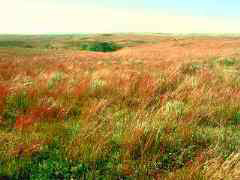The Grassland BiomeThe Grassland biome is dominated by grasses of a variety of species, all having adapted to the summer drought common to their semiarid habitat. The broad expanse of the grasslands is occasionally broken by stands of trees. The midlatitude grasslands of have been exploited more than any other biome by humans. Ninety nine percent of the United State's tall grass prairie and 70 percent of the mixed grass and short grass in some states have disappeared. Eight-five percent of the state of Iowa was once covered in native prairie, only one percent is left. The grasslands, especially the tall grass prairies are the world's most productive agricultural areas. The famous corn belt of the United States was created on top of the rich brown mollisol soils that developed beneath the surface. The PrairiesPrairies are found on the humid side of the grassland biome and are often referred to as the tall-grass prairie. A favorable annual moisture balance supports a dense ground cover of tall grasses. Grasses range in height between .6 to 1.2 meters (2 to 4 ft.), with some as tall as 8 feet or more on the eastern margin of the prairies in the United States. In the tall-grass prairie of Iowa, for example, typical grasses are big bluestem and little bluestem; a typical forb is black-eyed Susan. Trees and shrubs are generally limited to moist sites along stream channels or hill slopes facing away from the sun. The nutrient - rich soil beneath the grasslands drew farmers to these regions. Now, most natural tall-grass prairie has been replaced by agriculture. Extensive grasslands also occur in Argentina and the Ukraine.
Figure 13.20 Tall grass prairie once common to the eastern Great Plains of Kansas (Courtesy NRCS) The native grasslands of the world support a diversity of animal life. In North America, large grazers like the bison roamed the grasslands until hunted to near extinction by settlers moving west.
|
